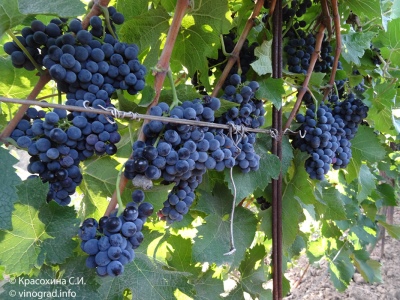
- Authors: Norbert Becker (State Institute of Viticulture, Freiburg, Germany)
- Appointment: technical
- Berry color: purple
- Ripening period: early
- Name synonyms: FR 437-82 r
- Yield: 130-160 c / ha
- Flower type: bisexual
- Density of the bunch: loose
- Berry shape: rounded
- Resistance to fungal diseases: highly resistant
Technical varieties are specially grown for the preparation of juices and wines. The Cabernet Cortis grape is considered one of the most famous wine varieties. The particular peculiarity of the species is in its taste. In this article, we will consider the features of grapes, the positive aspects, as well as the ripening time.
Breeding history
The grapes were bred in 1982 by the famous breeder Norbert Becker at the State Institute of Viticulture, which is located in Germany, Freiburg.
Description
Young shoots of grapes have a characteristic lemon color at the top. The leaves are large, with three lobes, there is an unevenness on the top of the foliage, there is a slight hairiness on the back. The bush is small, strongly spreads the vines.
The positive qualities include the fact that grapes tolerate a number of diseases well. He has a high level of resistance to sudden changes in temperature. It is unpretentious in care, has an early ripening period.
The disadvantages include the tendency to peas, the berries become smaller and have an unpleasant sour taste. The ovaries often crumble, this is due to pollination.
Ripening period
In terms of ripening, the culture is early maturing. The growing season is 130-148 days.
Bunches
The bunches are medium in size, even small in places, the stem is long, firmly attached to the vine. Density is closer to medium, polka dots are possible. The shape is cylindrical-conical, up to 15-20 cm long, 10 cm wide. There are also smaller clusters, but, according to gardeners, the fruits simply did not have enough nutrients. The weight of one brush is from 250 to 300 g.
Berries
The berries have a variety of shades - from blue with an admixture of black to black and purple. Round in shape, the skin is dense with a glossy bloom. The size of one berry is 1.5 cm. The pulp is juicy, dense, there are bones. In very small berries, the bones do not ripen.
Taste
Since the variety is technical, the amount of sugar in it is not so much, approximately 19-20%. There are notes of black currant and slight sourness.
Yield
The yield is medium-high, much depends on agricultural technology (pollination, feeding, pruning). On average, one hectare can ripen 130-150 centners.


Growing features
You can plant seedlings both in the spring and in the fall. Beforehand, the land should still be treated with fertilizer and thoroughly shed with water.The place should be such that there is not much wind blowing, and where there is enough sunlight. For grapes, it is worth choosing a larger site in order to install supports, since the bushes are creeping.
Landing
It is worth planting seedlings in open ground at a temperature of at least +15 degrees. This applies to both the spring and autumn. Especially it is worth paying attention to the planting region, at what time frosts usually occur.
In order to plant a seedling, it is necessary to form holes or a trench. The depth should be about 0.5 m, the diameter is the same. The seedlings have a root system of about 10 cm, so it makes no sense to dig a deep hole. Humus and soil with fertilizers are placed on the bottom. Before lowering the seedling, you should inspect the roots for rot, if the rhizome is in order, then you can plant it. The earth around the trunk should be tamped and mulched.

Pollination
Although grapes have flowers of both sexes, gardeners note that sometimes cross-pollination occurs poorly or weakly. Because of this, the ovary may fall off. In this case, it is necessary to carry out pollination artificially, or to fertilize the seedlings more strongly with growth stimulants.
Pruning
Young shoots should be shortened by 3-4 eyes, but two-year-old bushes are shortened only after harvest, 4-5 eyes, no more. Thinning this grape variety is also not worth it. This, on the contrary, will worsen the situation, and the plant will begin to weaken. Before pruning, it is worth disinfecting the pruning shears each time so as not to infect. All sections are processed with garden varnish.



Frost resistance and the need for shelter
Cabernet Cortis grapes are frost-resistant, can withstand up to -22 degrees. But if the weather phenomena are very ambiguous, then it is worth covering the bushes with a dense film, and spreading spruce branches on the ground.

Diseases and pests
Of all the pests that attack grapes, only the leafworm, spider mite and grape mite are really dangerous for Cabernet Cortis.
Precautions must be taken to avoid the spread of pests. Do not over-water the grapes, if the ground dries out poorly, then drainage is always done at the bottom of the hole before planting. Cut off diseased shoots and burn them away from the grapes. And also carry out preventive pollination 2 times a year.
With a spider mite, it is worth fighting with a soapy solution, sprayed in early spring.

If a grape is exposed to any disease or insect, this always affects its appearance.
Storage
Grapes keep well in crates.To do this, pour some sawdust into the box, and then put the grapes on it. The grade is technical, it is distinguished by good transportation. The shelf life is 1-2 months.











































































